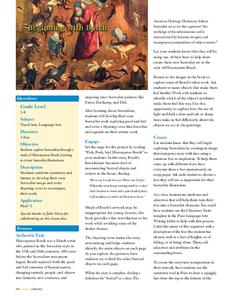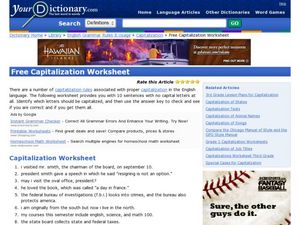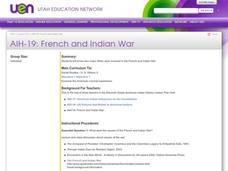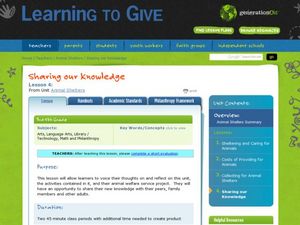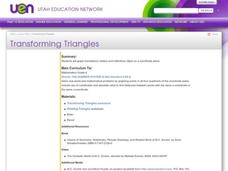Curated OER
Beginning with Bosch
Students become familiar with surrealism through the artwork of Hieronymus Bosch. In this Bosch lesson, students explore symmetry and surrealism. Students create step by drawings on the computer in the style of Hieronymus Bosch. Students...
Love to Know
Free Capitalization Worksheet
Not really a worksheet, but rather, a website that has 10 sentences void of all capital letters. Copy these onto a handout or project them on the wall for your class to use as practice. Answers follow, along with an explanation as to why...
Curated OER
Exporing Our Community
Students explore attributes of the community in which they live. They compare rural, urban and suburban communities and attempt to classify their own community. Each group illustrates their assigned area by drawing buildings, trees,...
Curated OER
Art as Therapy
Young scholars explore how they connect with artwork on an emotional level through writing and the creation of an original piece of art.
Curated OER
Dealing With Death
Students watch and analyze a video dealing with the topic of death. They answer discussion questions, identify examples of how death is represented in popular media, write a poem, create a memory book, and write a letter to someone who...
Curated OER
How Do Artists Get Their Ideas? Culture and Environment as Sources of Ideas
Students share the difficulties they have in determining what to write or draw for a project. In groups, they view examples from three different artists and discuss how their personal experiences affected their art. They brainstorm a...
Alabama Learning Exchange
Ready, Set,...Research!
Third graders complete a research project on a weather topic using a variety of resource materials. They demonstrate the use of dictionaries and encyclopedias. They write a report using the research material and grade level appropriate...
Curated OER
French and Indian War
Eleventh graders examine why major tribes were involved in the French and Indian War. They write a short paragraph about the causes and answer an essay question based on text and Internet research, citing sources. They research text...
Curated OER
A Picture Is Worth a Thousand Words
Students, after reading the book, "Esperanza Rising," create a virtual display by combining different story elements into a visual representation. They choose the setting and characters of a scene that will act as a springboard of ideas...
Curated OER
Fern
For this literature worksheet, students, after reading the book, Charlotte's Web, draw a picture of Fern, write a word that describes her (adjectives) on each line around the box and then write a sentence describing her personality.
Curated OER
Sharing Our Knowledge
Learners evaluate their participation in an animal welfare service project. For this animal welfare lesson, students reflect upon their experience by using their feelings and descriptions in their writing. Learners share their experiences.
Alabama Learning Exchange
Scrapping the Biomes
Fifth graders investigate biomes of the earth. In this biomes instructional activity, 5th graders explore eight different biomes which include the tropical rain forest, deciduous forest, grasslands, and taiga. They design an artistic...
Curated OER
Revolutionary War Spy Methods
Young scholars research how coded messages were used during the Revolutionary War. In this Revolutionary War lesson, students view primary documents about the Revolutionary War spies and the methods used for sending messages. Young...
Curated OER
Halogens
Students identify the elements that belong to the halogen family on the periodic table. For this chemistry lesson, students describe the common characteristics of elements in this group. They research about hydrochloric acid's effect on...
Curated OER
From Page to Screen
Students consider how xerographic photocopy machines and scanners operate. They discuss and practice using scanners, and brainstorm strategies to increase the efficiency of Google's scanning project.
Curated OER
Why Do Art?
Students examine the purposes of art and view examples of art created by artists, designers, and craftspeople. They write a report describing the various purposes for creating works of art.
Curated OER
Tadpole Diary
Second graders examine the life cycle by observing tadpoles. After reading the book, Tadpole Diary, they draw the stages of tadpole development and write sentences about what they think is happening.
Curated OER
Compare Human-made Objects with Natural Objects
Learners examine and observe how many human-made objects get their basic design from things in nature. They listen to the book "Nature Got There First," compare/contrast hollow bones with drinking straws, bird beaks and tool pliers, and...
Curated OER
Too Many Tamales
Students listen to the story "Too Many Tamales" by Gary Soto. Students use the internet to find recipes from around the world. They print out a recipe and put their name on it. The recipes are then combined into a class recipe book.
Curated OER
Earthquake of 1964
Young scholars examine the damage from the earthquake across a large geographic area of Alaska. They discover additional damage occurred from the tsunami, fires, and flooding after the initial earthquake. They collect images and...
Curated OER
Transforming Triangles
Sixth graders graph translations (slides) and reflections (flips) on a coordinate plane. They visualize and identify geometric shapes after applying transformations on a coordinate plane. Finally, 6th graders write a paragraph telling...
Curated OER
Elements of Art iMovie
Students are introduced to how to use the iMovie software. Individually, they write down their personal beliefs and feelings to use in their movie. To end the lesson plan, they use the elements of design to develop and create their movie...
Curated OER
Center Stage—Focus on Poverty
Students explore the concept of philanthropy. In this service learning lesson, students examine stereotypes and discrimination based on socio-economic status. Students prepare to work with people of diverse backgrounds in service...
Alabama Learning Exchange
No More Money Trouble
Young consumers explore money identification and counting. In this cross-curricular money instructional activity, they participate in comprehension and writing activities prior to and after reading the book Money Trouble by Bill Cosby....


